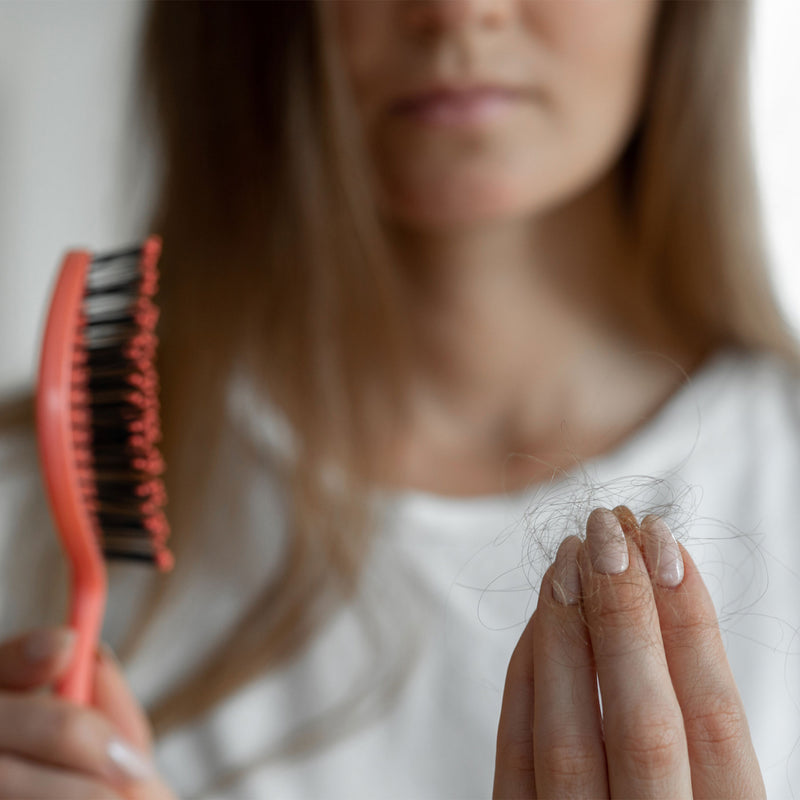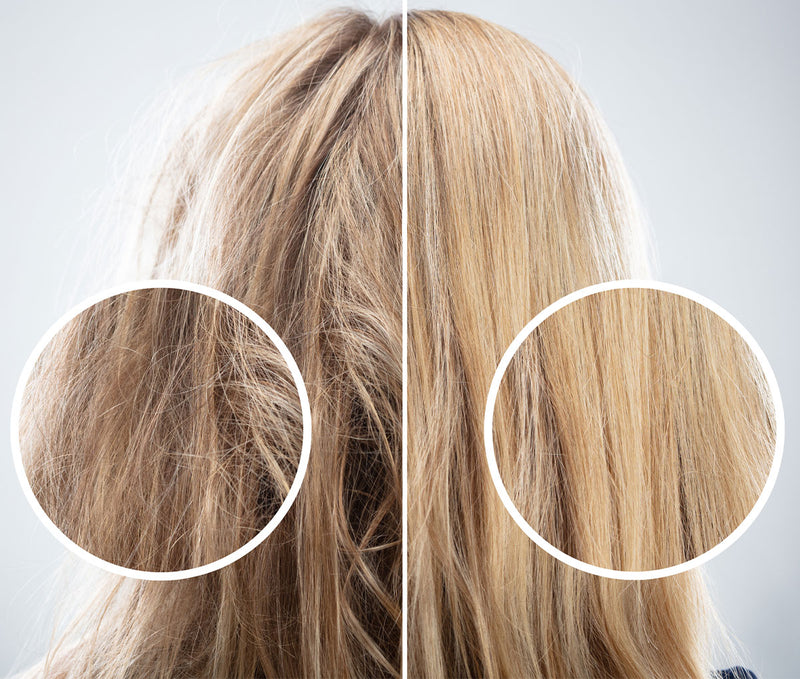The Holistic Approach
Hair thinning and loss after pregnancy is a common experience for many new moms, in fact, about 40-50% of women experience postpartum hair loss. If you're one of them, know that you are not alone. While it may be disheartening to see an increase in hair shedding after giving birth, it's important to understand that this is a natural process. The hormonal changes during pregnancy and postpartum can cause hair to fall out at a faster rate than usual. But don't worry, there are ways to combat postpartum hair loss and restore your hair volume. In this article, we will discuss general techniques for caring for your hair, including using volume shampoo and nourishing treatments like Redensyl or Minoxidil. However, it's always recommended to consult your doctor before making any changes to your hair care routine. Let's dive into the steps that can help moms beat postpartum hair loss and regain their hair volume.

The Foundation of Hair Care - Proper Washing Techniques
Maintaining a healthy head of hair starts with the foundational act of regular cleansing. This not only removes the buildup of daily pollutants and styling products but also prevents the scalp from becoming overly greasy or dry. The frequency of shampooing is not a one-size-fits-all prescription; it deeply depends on your hair type and the oil production level of your scalp. For instance, those with fine hair or an oily scalp might find benefit in washing their hair more frequently, potentially even daily, to manage oil levels and maintain volume. Conversely, individuals with coarse or dry hair may only need to shampoo once or twice a week to prevent stripping their hair of natural oils which are essential for maintaining moisture and preventing breakage.
A key ingredient to look for in shampoos, especially for those aiming to clarify the scalp and ensure hair follicles are unclogged, is tea tree oil. Known for its antimicrobial and anti-inflammatory properties, tea tree oil is excellent for cleansing the scalp, removing dead skin cells, and ensuring clean pores, which is critical for healthy hair growth. Incorporating a volumizing shampoo into your routine can also aid in lifting the hair from the roots, providing an appearance of fuller hair, which is especially beneficial for those experiencing thinning or hair loss. Remember, the goal is to find a balance that works for your specific hair and scalp type, allowing for optimal health and hair volume.
Conditioning - Locking in Moisture for Fuller Locks
Conditioning plays a crucial role in maintaining healthy, voluminous hair. It acts by smoothing and detangling hair, significantly reducing the risk of breakage and the appearance of split ends. According to New York City-based hairstylist Chuck Bass, "Conditioning every time you shampoo...adds moisture back, softens, and detangles." The process of conditioning not only replenishes the hair with necessary moisture but also makes it far easier to comb and style.
When applying conditioner, it's essential to tailor your approach to your specific hair type. For those with curly or dry hair, a deep conditioning treatment or a leave-in conditioner can offer the extra hydration needed to maintain bounce and prevent frizz. Individuals with fine or straight hair might opt for a lightweight conditioner that doesn't weigh the hair down, thereby preserving volume. Wavy hair types can benefit from a balance of moisture and lightweight formulas to enhance texture without sacrificing body.
For every hair type, it's beneficial to use conditioners that have vital ingredients for boosting volume. Biotin, or vitamin B7, is especially important for making hair stronger and improving its texture. This leads to healthier growth and reduces thinning by strengthening hair from root to tip, which helps achieve a fuller appearance. Including other key ingredients like arginine, hyaluronic acid, and Redensyl can also greatly improve the volume and health of your hair. By following expert advice and choosing products tailored to your hair’s needs, you can significantly improve its condition and thickness.

Proper Drying - The Overlooked Step in Hair Care
Proper drying is an often overlooked yet critical step in a comprehensive hair care routine. Incorrect drying techniques can significantly harm your hair, leading to breakage and excessive dryness of both hair and scalp. After investing time in washing and conditioning your hair, it’s vital to ensure your drying method doesn't undo all that hard work. Traditional towel drying, if done aggressively, can rough up the hair cuticle (the outer layer of the hair), resulting in frizz and damage. As an alternative, consider air drying as a gentle method, particularly for those with sensitive or damaged hair. Air drying allows your hair to dry naturally, minimizing the risk of heat damage and preserving the integrity of your hair.
For individuals with curly or textured hair, using an old, soft T-shirt instead of a towel can help reduce frizz by absorbing excess water without disrupting the hair's natural curl pattern. The smooth texture of a T-shirt is less abrasive than the rough fibers of a towel, making it an excellent choice for gentle drying.
To further protect and ease the detangling process, generously apply a leave-in hair detangler after towel or T-shirt drying. This step not only aids in smoothing out knots but also infuses your hair with moisture, enhancing manageability and preparing it for stress-free combing or brushing. Choose a detangler formulated for your hair type for optimal results, allowing for a smoother transition to styling and reducing the potential for damage.
When it comes to detangling, using the right tool is crucial. A wet brush, designed specifically for use on wet hair, can gently untangle knots without pulling or breaking the strands. For those with wavy or curly hair, brushes with wide-set steel bristles can effectively navigate through curls without disrupting their natural shape. Conversely, individuals with fine hair may find that a wide-tooth comb works best, as it delicately separates hair strands without causing stress or breakage.
By choosing the appropriate drying method and tools for your hair type, you not only protect your hair from unnecessary damage but also set the stage for easier styling. This mindful approach to drying can enhance the overall health and appearance of your hair, contributing to a fuller and more voluminous look.
Boosting Volume - Natural Remedies for Hair Loss
The spectrum of hair treatments beyond shampoo and conditioner ranges from prescription medications and surgical options to completely natural remedies and everything in between. For the purpose of this discussion, we’ll focus on specialized ingredeints that are commonly sought out by women dealing with hair thinning and loss concerns, such as Redensyl, Capixyl, and Minoxidil, alongside other nourishing treatments like scalp scrubs and hair masks.
Minoxidil is a well-known topical treatment that stimulates hair growth and has been used widely for treating women's hair loss. However, Redensyl has emerged as a compelling alternative, particularly appealing as it is naturally-derived and provides a non-hormonal approach. Unlike Minoxidil, which can sometimes cause scalp irritation and is linked to an extra shedding phase, Redensyl targets hair follicle stem cells, promoting a more natural growth cycle without the adverse effects. This makes Redensyl an attractive option for many women, especially those who are postpartum and seeking a gentler solution. Capixyl, another innovative ingredient derived from natural sources, works by reducing scalp inflammation and strengthening hair follicles to prevent hair loss.
If thinning and loss is not so much of a concern for you, treatments to encourage sheen, styling manageability and health are great additions to your overall regimen plan. Moreover, the integration of hair care products such as scalp scrubs, which cleanse pores and improve scalp health, alongside hair masks for deep conditioning, and general hair oils for added nourishment and shine, can enhance the overall quality and thickness of hair. These supplementary treatments not only support hair growth but also fortify the hair's structure, making them essential components of a comprehensive hair care strategy.
While postpartum hair loss is a common and natural occurrence, understanding that this phase is temporary can provide some comfort. Postpartum hair loss often lasts between six and 24 weeks
and in some cases as long as 15 months. With the right treatments, such as Redensyl for those looking for a non-hormonal approach, and a comprehensive hair care routine, it is possible to shorten this window of hair loss and support your hair's return to its pre-pregnancy volume and health.
Remember, before making any significant changes to your hair care regimen, it’s vital to consult with your physician, especially when considering treatments for postpartum hair loss.

Styling Without Compromise
Exploring the nuances of hair care after childbirth reveals a widespread strategy many turn to for both practicality and personal renewal: adopting a new hairstyle. This choice isn't purely for aesthetic delight; it becomes a necessary adjustment for individuals facing changes in their hair's texture or density due to postpartum hair loss.
The well-known "mom bob" is a testament to this, striking a balance between ease of maintenance and fashionable flair. However, some opt for this haircut to manage thinning hair with grace or simply for a refreshing change. When considering a haircut during this transitional phase, it’s pivotal to choose one that compliments your natural hair texture. This strategic choice minimizes styling efforts and maximizes the potential for your hair to look its best with minimal fuss. For those looking to reduce length without sacrificing versatility, a long bob emerges as a prime option. It offers enough length for varied styling while eliminating the bulk that can weigh down thinning hair.
Bangs, too, present an elegant solution for new moms wishing to refresh their look without a dramatic length change. Beyond just aesthetics, bangs serve a practical purpose by covering any patchy areas, seamlessly integrating into your look with a bit of styling. However, it’s essential to avoid tight hairstyles that pull on the roots, as these can aggravate hair loss and potentially lead to traction alopecia. Embracing looser, gentler styles not only protects your scalp but also supports the health of your hair during this period of regrowth.
View your postpartum hairstyle as a transitional tribute to motherhood—a temporary adaptation as you navigate this new chapter. With time and the right care, including gentle styling and avoiding practices that could lead to traction alopecia, your hair volume is likely to return, opening up even more possibilities for hair styles for thin hair and beyond. This phase, though challenging, is an opportunity for exploration and self-care, reflecting the ongoing journey of adjustment and renewal that motherhood embodies.

Protect and Nourish - The Final Touch
Embarking on a holistic hair care journey requires a commitment not just to the products we use but to the lifestyle choices we make. Protecting and nourishing your hair goes beyond the basic steps of washing, conditioning, and applying treatments. It encompasses a mindful approach to how we treat our hair daily, from the gentle way we dry it to the protective styles we choose.
By incorporating the right shampoos and conditioners along with treatments that make sense for our individual needs, we lay the foundation for healthy volumnous hair and overall hair and scalp health. But it's also crucial not to overlook the significance of protecting your hair from environmental stressors and styling damage. Embrace silk pillowcases to reduce friction, minimize the use of heat styling tools, and when you do use them, always apply a heat protectant. The path to restoring and maintaining your hair’s volume and beauty, especially in the wake of postpartum changes, is paved with consistent care, gentle handling, and an awareness of the products that best suit your individual needs.
Remember, taking control of your hair care routine and making informed choices about how to protect and nourish your hair can bring significant improvements. There is hope for those experiencing thinning, and with the right regimen, you can see tangible results. Your hair is an extension of you, and by giving it the care it deserves, you honor your body's natural rhythms and resilience.






